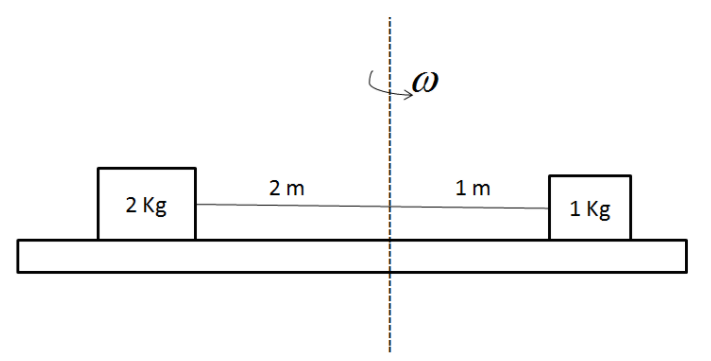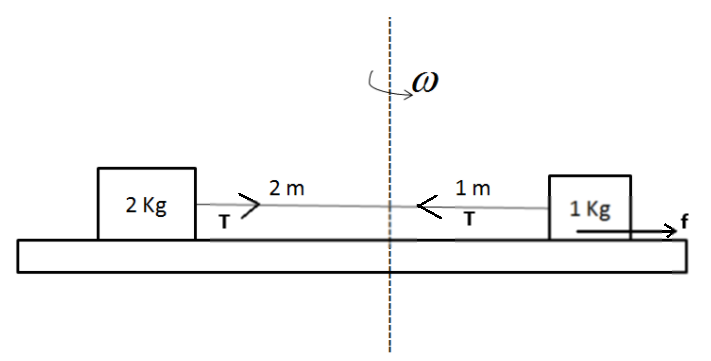
Find tension in the string, force of friction on 1Kg block and its direction.

A. T=64N, f=48N (inwards)
B. T=48N, f=64N (outwards)
C. T=64N, f=64N (inwards)
D. T=64N, f=48N (outwards)

Answer
513.6k+ views
Hint: The given problem is based on centrifugal force in circular motion and newton’s action-reaction law. Here tension force and friction force on blocks will balance the centrifugal forces on both blocks due to circular motion.
Complete step by step answer:
As we know that when a particle is in circular motion about a fixed point then a centrifugal force acts on it that will try to force the particle away from the fixed point. And due to Newton's action-reaction law the centrifugal force will be balanced by tension force in string and friction force on particles. Here we use this concept to solve a given problem.
The given data in question as
${m_1}$= 1 Kg
${m_2}$= 2 Kg
${r_1}$= 1m
${r_2}$= 2m
ω= 4 rad/sec
The situation of blocks can be drawn as

Where T= Tension in string
f= Friction on 1kg block
Now we balance the forces
For block 2 kg:
$
T = {m_2}{r_2}{\omega ^2} \\
\Rightarrow T = 2 \times 2 \times {4^2} \\
\Rightarrow T = 64N \\
$
For block 1 kg:
$
{m_1}{r_1}{\omega ^2} = T - f \\
\Rightarrow 1 \times 1 \times {4^2} = 64 - f \\
\Rightarrow f = 64 - 16 = 48N(outwards) \\
$
Hence, the correct answer is option (D).
The line of action of centrifugal force in circular motion always passes through the fixed point that is the center of circular motion. So the line of action of friction force, tension force and centrifugal force, all are acting along the same line. So these forces balance each other to execute circular motion.
Note: Sometimes we consider the direction of centrifugal force in inward direction. But we should always remember that centrifugal force is a pseudo force that acts on the particle to take it in equilibrium due to centripetal force.
Complete step by step answer:
As we know that when a particle is in circular motion about a fixed point then a centrifugal force acts on it that will try to force the particle away from the fixed point. And due to Newton's action-reaction law the centrifugal force will be balanced by tension force in string and friction force on particles. Here we use this concept to solve a given problem.
The given data in question as
${m_1}$= 1 Kg
${m_2}$= 2 Kg
${r_1}$= 1m
${r_2}$= 2m
ω= 4 rad/sec
The situation of blocks can be drawn as

Where T= Tension in string
f= Friction on 1kg block
Now we balance the forces
For block 2 kg:
$
T = {m_2}{r_2}{\omega ^2} \\
\Rightarrow T = 2 \times 2 \times {4^2} \\
\Rightarrow T = 64N \\
$
For block 1 kg:
$
{m_1}{r_1}{\omega ^2} = T - f \\
\Rightarrow 1 \times 1 \times {4^2} = 64 - f \\
\Rightarrow f = 64 - 16 = 48N(outwards) \\
$
Hence, the correct answer is option (D).
The line of action of centrifugal force in circular motion always passes through the fixed point that is the center of circular motion. So the line of action of friction force, tension force and centrifugal force, all are acting along the same line. So these forces balance each other to execute circular motion.
Note: Sometimes we consider the direction of centrifugal force in inward direction. But we should always remember that centrifugal force is a pseudo force that acts on the particle to take it in equilibrium due to centripetal force.
Recently Updated Pages
Class 11 Question and Answer - Your Ultimate Solutions Guide

Master Class 11 Accountancy: Engaging Questions & Answers for Success

Master Class 11 Physics: Engaging Questions & Answers for Success

Master Class 11 Business Studies: Engaging Questions & Answers for Success

Master Class 11 Maths: Engaging Questions & Answers for Success

Master Class 11 Chemistry: Engaging Questions & Answers for Success

Trending doubts
1 ton equals to A 100 kg B 1000 kg C 10 kg D 10000 class 11 physics CBSE

Difference Between Prokaryotic Cells and Eukaryotic Cells

One Metric ton is equal to kg A 10000 B 1000 C 100 class 11 physics CBSE

What is the opposite of entropy class 11 chemistry CBSE

Proton was discovered by A Thomson B Rutherford C Chadwick class 11 chemistry CBSE

1 Quintal is equal to a 110 kg b 10 kg c 100kg d 1000 class 11 physics CBSE




